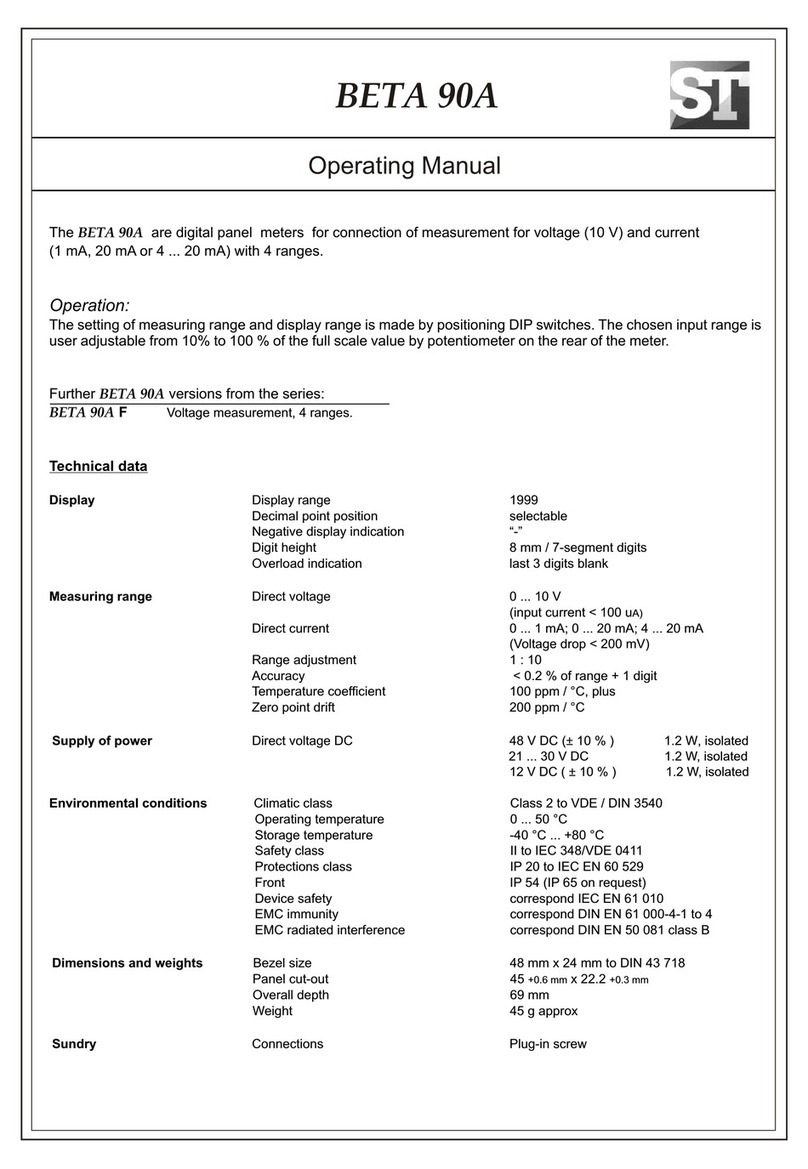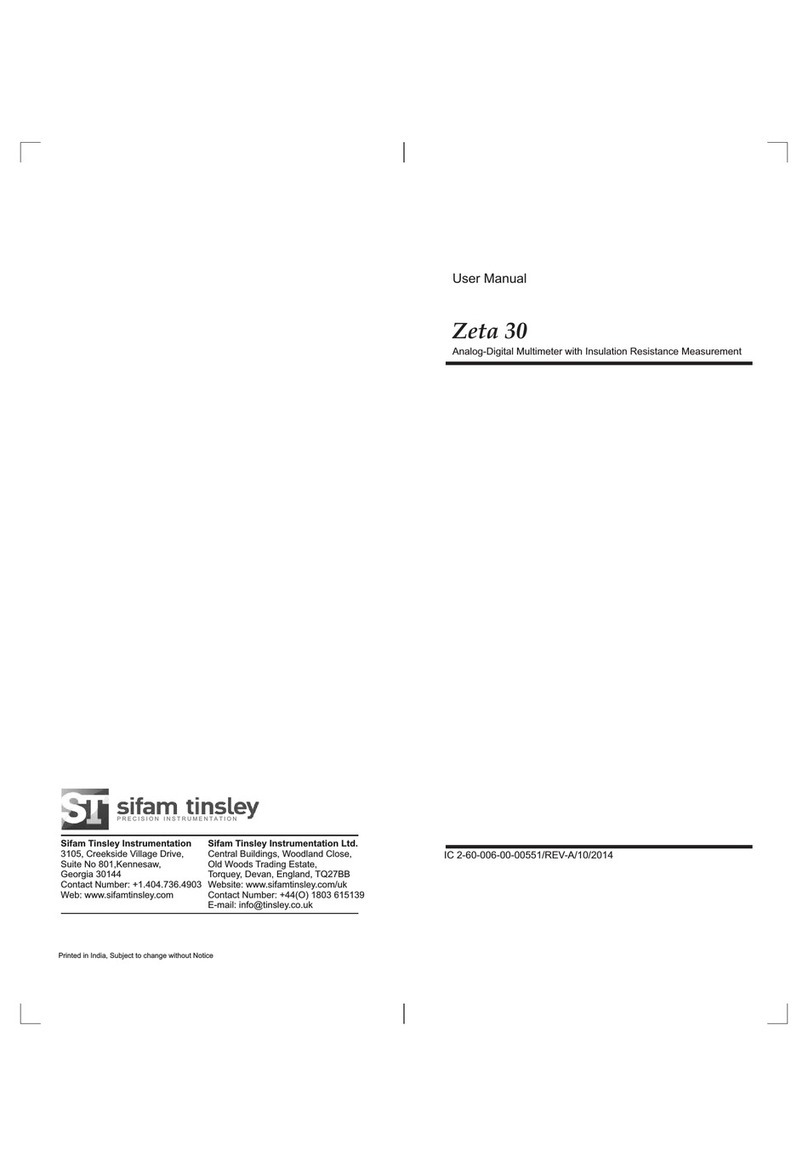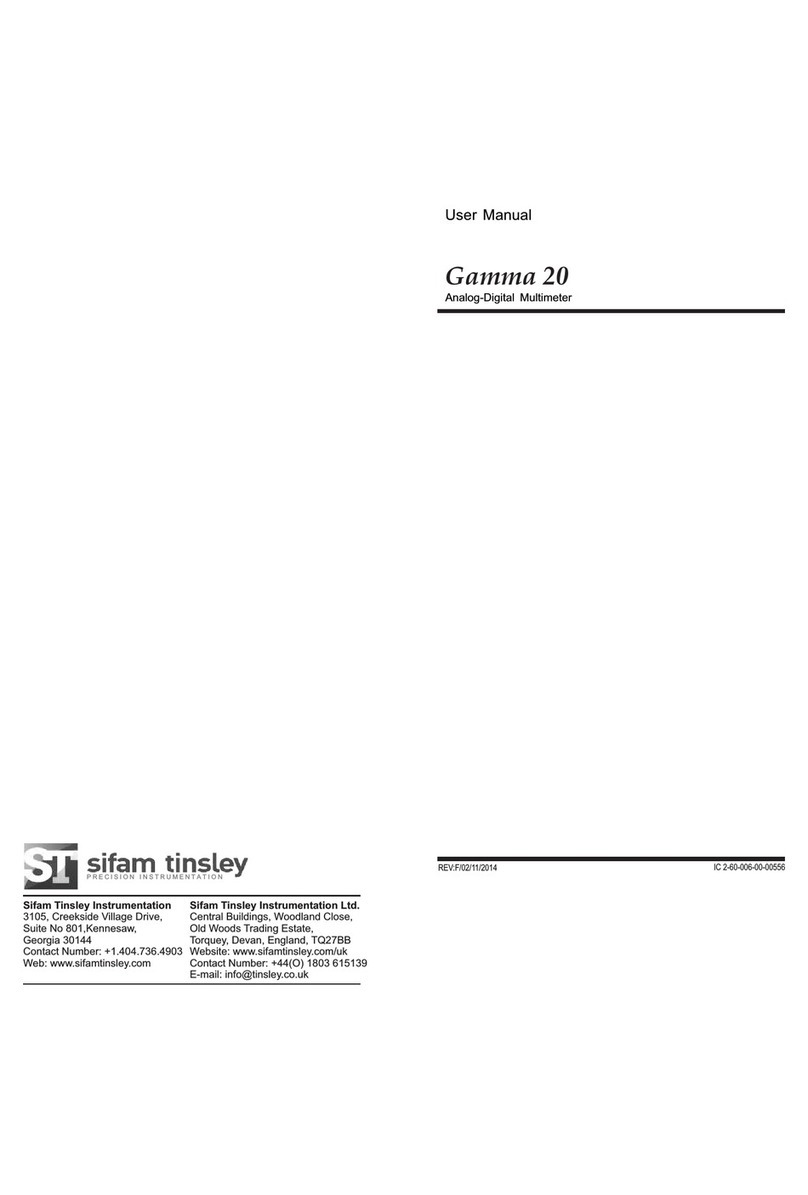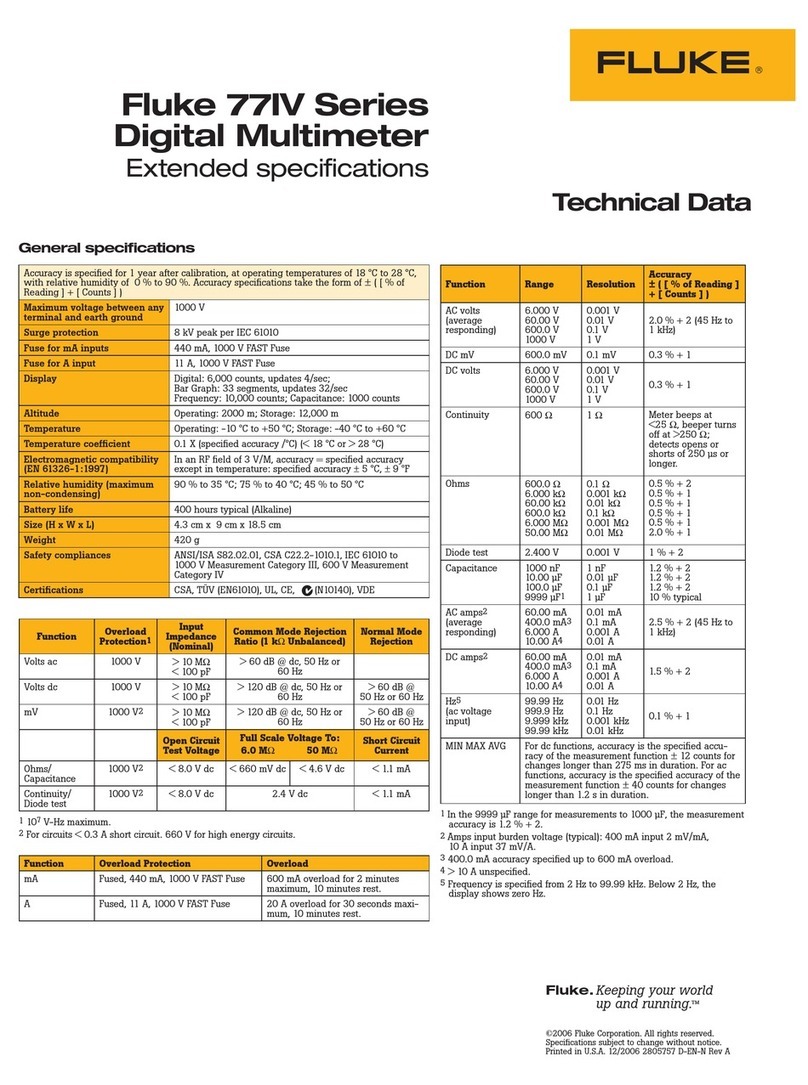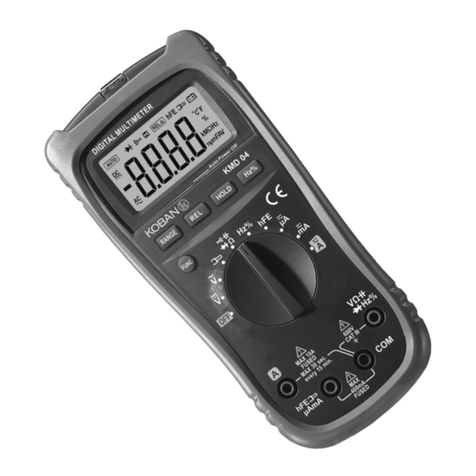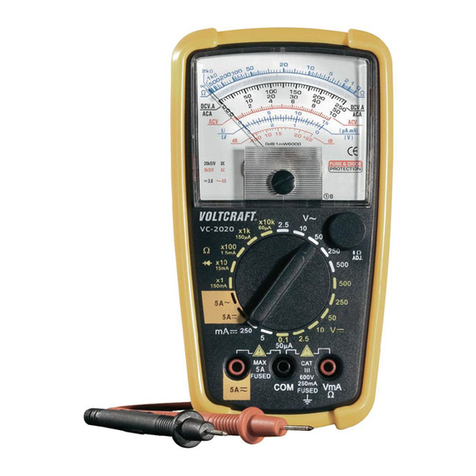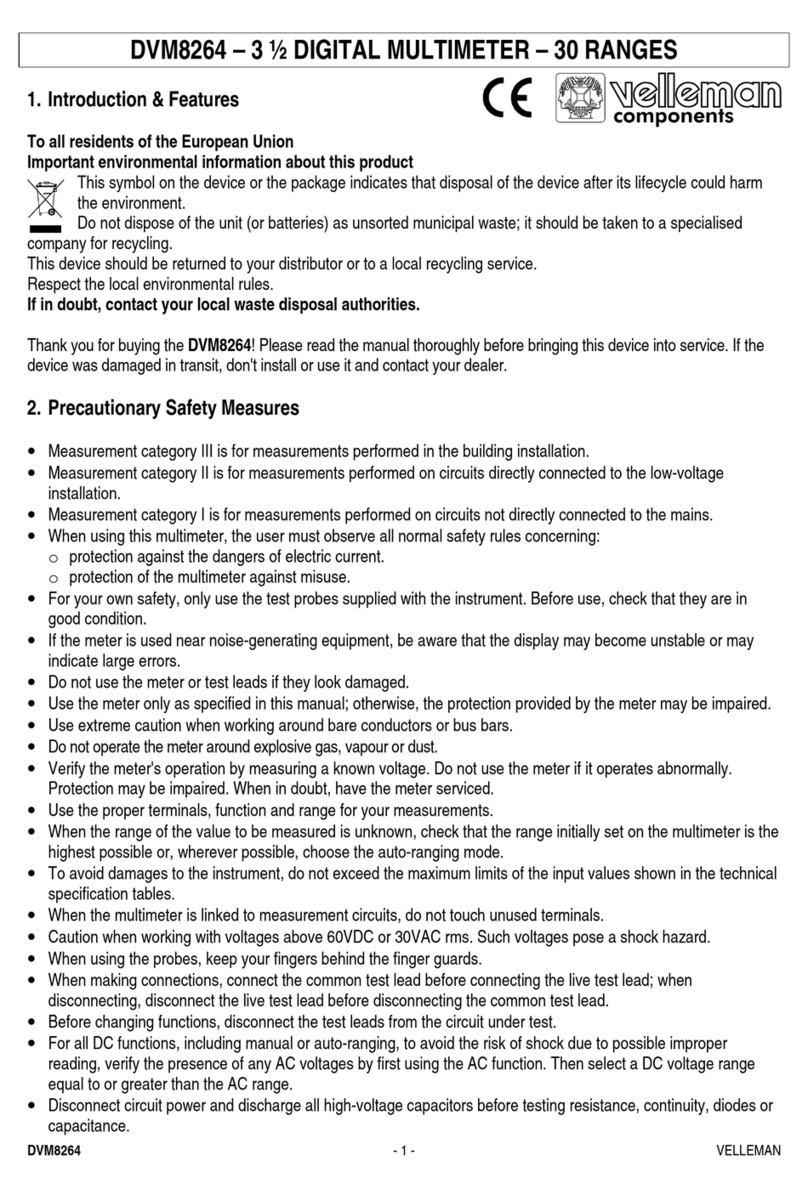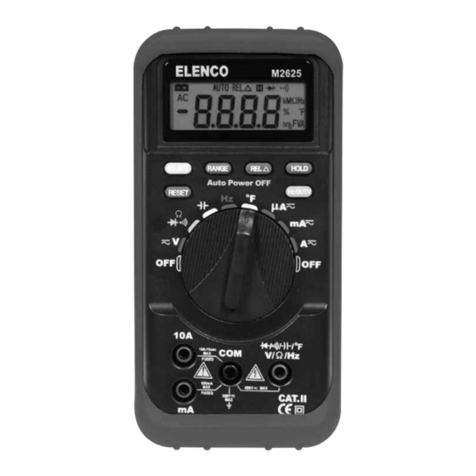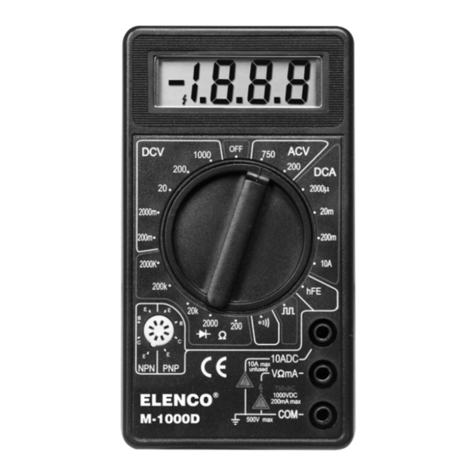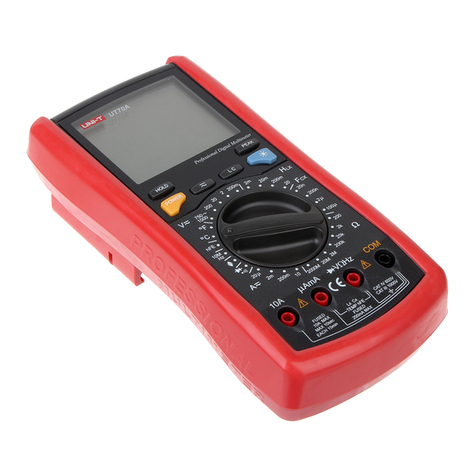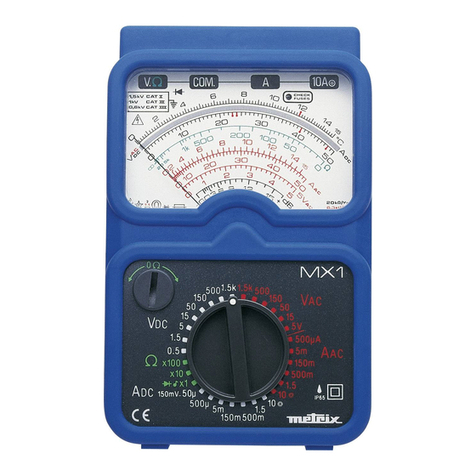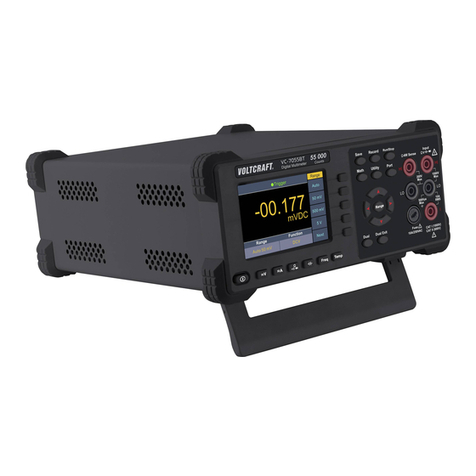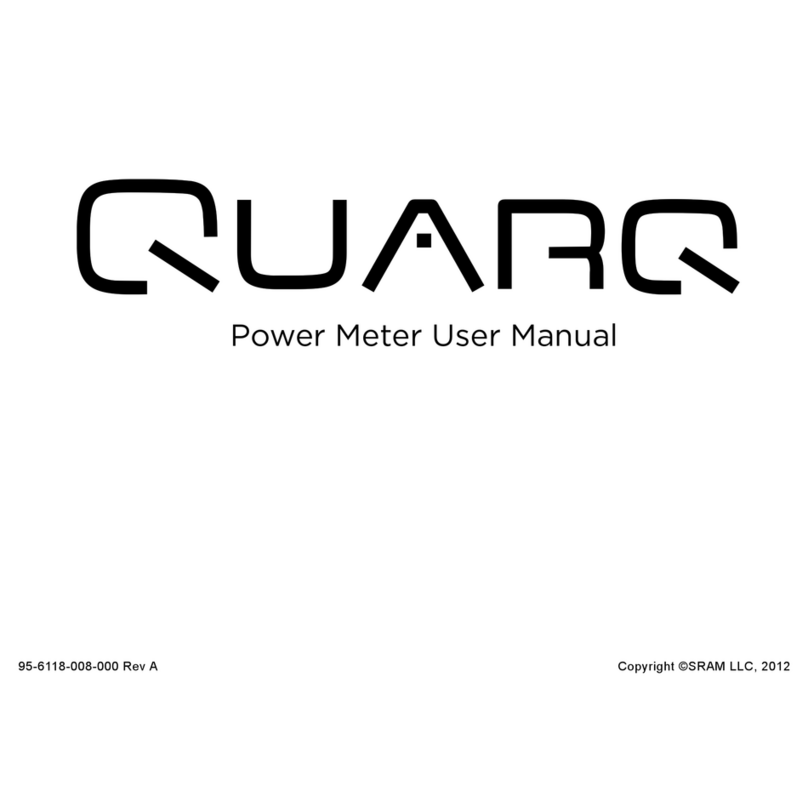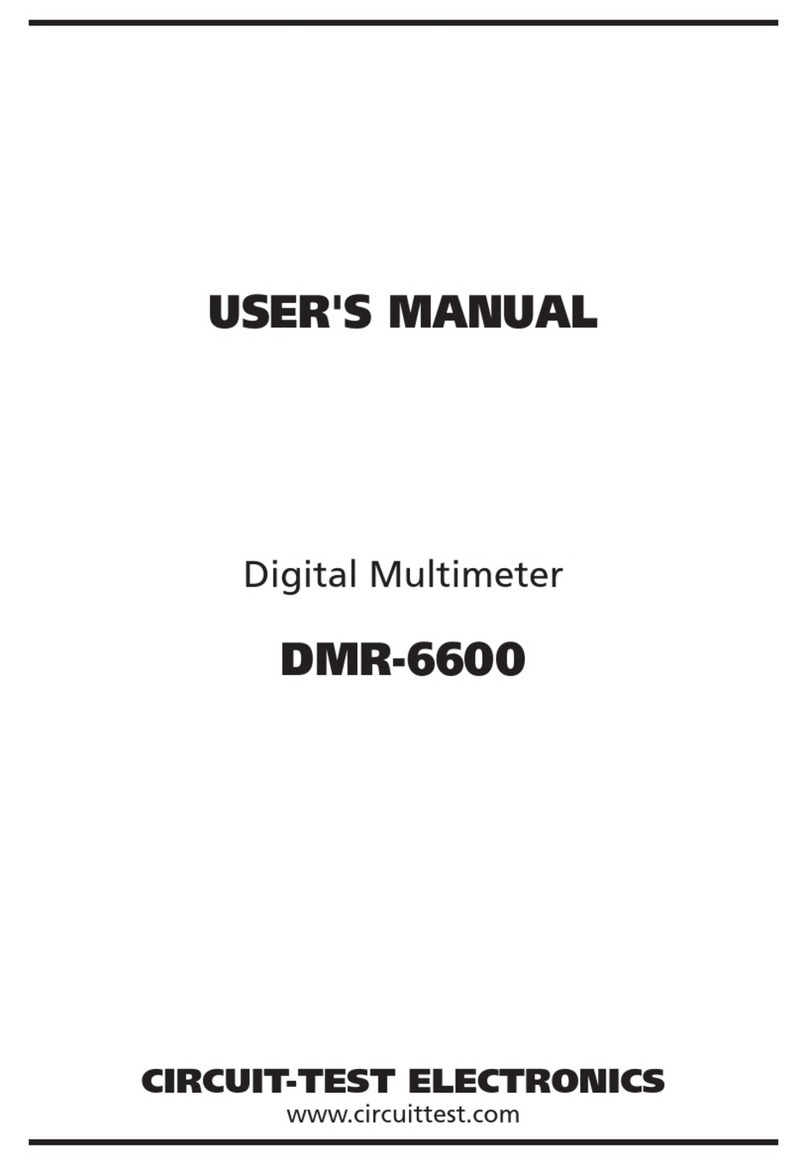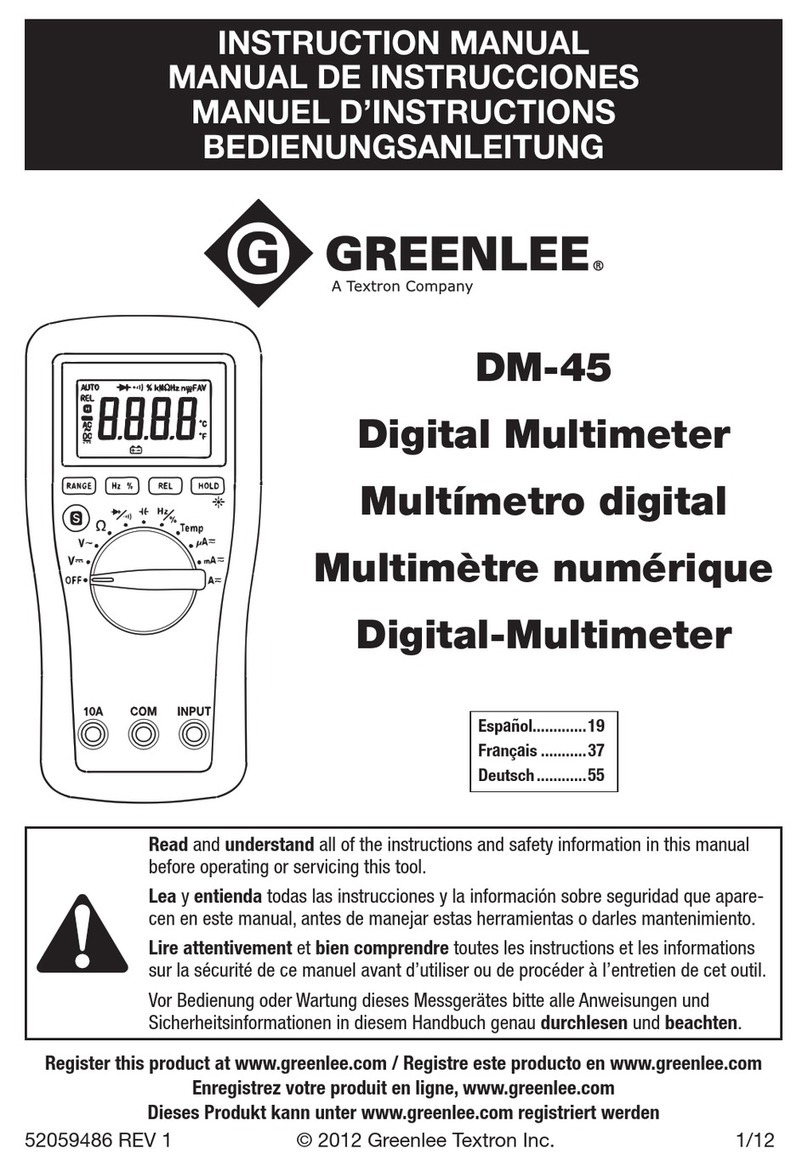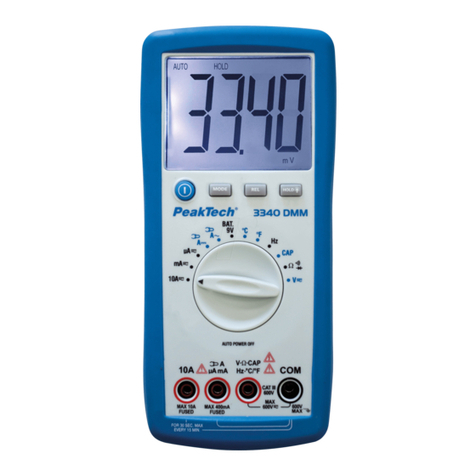Sifam Tinsley Gamma 10 User manual

Printed in India, Subject to change without Notice
User Manual
Analog-Digital Multimeter
Gamma 10
IC 2-60-006-00-00555/REV:A/15/05/2013
P R E C I S I O N I N S T R U M E N T A T I O N
Manufactured by:
Sifam Tinsley Instrumentation Inc
3105 Creekside Village Dr,
Unit 801, Kennesaw GA 30144
Distributed by:
Veracious Canada Inc
1101 Britannia Rd E,
Mississauga, ON L4W 3X1
Contact: +1 416-640-5364
Fax: +1 416-981-3933
E-mail: [email protected]
Web: www.veraciousinc.com

(12)
(11)
(13)
VA
DC
AC
-30
KW MW
kHz dB
nF
mF
mm
(8) (9) (10)
(16) (15) (14)
(20)
(19)
(18)
MIN
MAX t ON EVENTS
ON
-30.999
-10
0 -20
MAN
DATA
(17)
Zero
Zero
VA
MIN
MAX I ON EVENTS
DC
AC
ON
-8:8:8:8.8
-100
0 -200 -300
MAN
DATA
KW MW
kHz dB
nF
mF
mm
Gamma 10
(1)
(2)
(3)
(4)
(5)
(6)
mV
DC
-289.53
300 mA 10 A
(7)
100 200 300
ON
OFF
MAX
DATA
MIN/MAX
mA A
1000 V CAT II / 600 V CAT III
ON
V W
1000 V
fused
0
TRMS AC
TRMS AC+DC
MIN
AUTO
MAN
F0C
F
---
W
Hz
dB
V
---
V~
V
---
mA
---
0C
---
A
Scope of Supply:
1) Meter 2) Cable set
3) Spare Fuse 4) Safety Cover
5) Belt 6) Battery
7) User Manual 8) Warranty Card
9) Test Certificate
WARRANTY
Dear Customer,
You are now the privileged owner of Gamma 10 Digital Multimeter / Accessories, a
product that ranks the first of its kind in the world.
Company provides 36 months warranty from the original date of purchase against
defective material and workmanship.
In the unlikely event of failure of this meter / accessories within the warranty period,
Company will repair the meter / accessories free of charges. Please hand over the
meter / accessories to the dealer / Stockiest from whom you have purchased along
with this card and relevant cash memo / Invoice. This warranty entitles you to bring
the meter / accessories at your cost to the nearest stockiest / dealer and collect it
after repairs.
NO TRANSPORTATION CHARGES WILL BE REIMBURSED
The warranty is not valid in following cases:
1) Warranty card duly signed / stamped and original cash memo / invoice are
not sent along with the meter / accessories.
2) Complete warranty card is not presented to authorised person at the time of
repairs.
3) Meter / accessories not used as per the instruction in the user manual.
4) Defect caused by misuse, negligence, accidents, tampering and acts of
god.
5) Improper repairing by any person not authorised by the company.
6) Any sort of modification, alteration is made in electrical circuitry.
7) Seal provided inside is broken.
Warranty of Digital Multimeter / Clamp meter / Accessories does not cover fuses
and battery. Incase of dispute to the validity of warranty, the decision of Company’s
service center will be final.
If you brought this meter / accessories directly from the company, and if you notice
transit Damage, then you must obtain the insurance surveyors report and forward it
to Company.
Thank you.
Serial Number :
Date of Purchase :
Cash Memo / Invoice No. :
Dealer’s Signature :
Dealer’s Stamp :
(To be filled by authorized dealer)
Model No. :

Contents
(1) Liquid crystal display
(2) ON / OFF pushbutton
(3) Pushbutton for data hold and
MIN/MAX storage functions
(4) Pushbutton for manual range
selection
(5) Multi-function pushbutton
(6) Function selector switch
(7) Terminal sockets with automatic
blocking system
(8) Symbol for “CONTINUOUSLY
ON”
(9) Digital display with indication of
decimal point and polarity
(10) Symbols for displaying
selected functions
(11) Display for selected function
(12) Display for the unit of
measured quantity
(13) Over range indication
(14) Pointer for analog indication
(15) Scale for analog indication
(16) Indication that negative analog
range is exceeded
(17) Activated stop watch indicator
(18) Zero adjust indicator
(19) Low battery indicator
(20) Buzzer indication
1. Safety features and safety precautions................................................. 4
2. Switching the meter on.......................................................................... 5
3. Function and range selection................................................................ 6
3.1 Autoranging........................................................................................... 6
3.2 Manual range selection......................................................................... 6
4. Liquid crystal display.............................................................................. 7
4.1 Digital display......................................................................................... 7
4.2 Analog indication................................................................................... 7
4.3 Backlit..................................................................................................... 7
5. “DATA” hold / compare facility .............................................................. 7
6. Minimum value and maximum value “MIN/MAX” storage facility
with time display..................................................................................... 8
7. Voltage measurement............................................................................ 8
7.1 Voltage measurement on electrical systems up to 1000 V
with the KS30 measuring adapter.......................................................... 9
7.2 AC level measurement (dB)................................................................... 9
8. Current measurement............................................................................ 11
AC Current measurement with (clip-on) current transformers............. 13
9. Resistance measurement and continuity test....................................... 13
10. Diode test and continuity test................................................................. 15
11. Capacitance measurement .................................................................... 15
12. Frequency measurement ....................................................................... 15
13. Temperature measurement ................................................................... 16
14. Event counter ......................................................................................... 17
15. Stop watch .............................................................................................. 17
16. RS 232C interface................................................................................... 18
17. Specifications.......................................................................................... 20
18. Maintenance .......................................................................................... 28
18.1 Battery ..................................................................................................... 28
18.2 Fuses ....................................................................................................... 28
18.3 Case ........................................................................................................ 29
19. Repair and replacement parts service .................................................... 29
20. Appendix .................................................................................................. 29

—The multimeter must be operated only by persons who understand the
danger of shock hazards and know how to apply safety precautions.
Shock hazards exist wherever voltages of more than 30 V (TRMS) can
appear.
—Do not work alone in shock hazardous environment while carrying out
measurement.
—The maximum permissible voltage between any of the terminal sockets
(7) and ground is 1000 V.
—Take into account that unexpected voltages can occur on devices under
test (e.g. defective instruments). Capacitors may be charged to a
dangerously high voltage, for instance.
—Verify that the test leads are in good condition, e.g. no cracked insulation,
no open circuits in the leads or connectors.
—This meter must not be used for measurements on circuits with corona
discharge (high voltage).
—Be particularly careful when measuring on HF circuits. Dangerous
composite voltages may exist there.
—Measurements under moist environmental conditions are not permitted.
—Do not exceed the permissible overload limits of the measuring ranges.
See Table “measuring ranges” under “17. Specifications”.
—All current measuring ranges, are fused. The maximum permissible
voltage of the measuring circuit (=nominal voltage of the fuse) is 1000 V
AC/DC on the “mA” ranges, “A” ranges.
—You must only use the meter in power systems, when the current circuit is
protected by a fuse or a circuit breaker of 20 A, and when the nominal
voltage of the system does not exceed 1000 V.
For safe voltage measurements on power systems, up to 1000 V we
recommend the KS30 measuring adapter, which is available as accessory. Its
internal resistance limits the measuring current in the case of overvoltage and
incorrect operation and safely suppresses sparking from spark gaps. Also
refer to Section “7.1 Voltage measurement on electrical systems upto 1000V
with the KS30 measuring adapter”.
1. Safety features and safety precautions
You have chosen a meter which offers you a very high degree of safety.
The analog/digital multimeter Gamma 10 is manufactured in compliance
with the safety standards IEC 61010-1:2001.
In case of incorrect use or careless handling, the safety of both user and
multimeter is not assured.
To maintain the safe and proper condition of the meters and to ensure
their safe operation, it is absolutely necessary to carefully and
completely read these operating instructions before using any meter.
These instruction must be followed in all respects.
For your safety and for protection of the meter, the Gamma 10 meter is
fitted with an automatic terminal blocking system. It is coupled with the
function selector switch, which blocks the terminal sockets not necessary
for measurement.
Please note the following safety precautions:
Fuse replacement
Open the meter same as for battery replacement.
Remove the blown fuse, e.g. with the aid of a probe, and replace it with
a new one.
permissible types
- for current measuring ranges up to 300mA:
Type FF(UR) 1.6A / 1000V AC/DC; (10kA); 6.3mm x 32mm
- for the 3A and 10A current measuring ranges :
Type FF(UR) 1.6A / 1000V AC/DC; (30kA); 10mm x 38 mm
Caution :
Absolutely verify that the specified fuse is installed!
If a fuse of other cut-out capacity, other nominal current or other switching
capacity is used, a dangerous situation exists for you, and there is danger of
damaging protective diodes, resistors or other components.
The use of mended fuses of shorting of the fuse holder is not permissible.
18.3 Case
Special maintenance of the case is not required. Take care that the surface
between the connection sockets is clean. For cleaning take a moist cloth.
Avoid scrabbing.
19 Repair and replacement parts service
When you need service, please contact :
20. Appendix
20.1 AC current measurement with (clip-on) current
transformers
20.1.1 Transformer output mA/A
Caution :
If current transformers are operated with an open circuit on the secondary side,
e.g. due to defective or disconnected leads, a blown fuse in the meter, or a wrong
connection, dangerously high voltages can occur at the connectors. Therefore,
verify that the current circuit of the meter and the secondary winding of the
transformer connected to the meter form an intact circuit. Connect the transformer
to the sockets ^ and mA and/or A.
The maximum permissible operating voltage is the nominal voltage of the current
transformer. When reading the measured value, take into account the transformer
ratio and the additional error in indication.
20.1.2 Transformer output mA/A
Several transformers are fitted with a voltage output (designation mV/A).
The secondary output must therefore be connected to the connection sockets ^
and V

Ambient conditions
0 0
Functional temperature range -20 C... + 50 C
0 0
Storage temperature range -25 C... + 70 C
Climatic class 2z/-20/50/70/75 % with reference to
VDI / VDE 3540
Altitude up to 2000 m
Mechanical configuration
Protection type IP 50 for the connection sockets IP 20
according to DIN VDE 0470 Part 1 / EN
60529
Dimensions 84 mm x 195 mm x 35 mm
Weight 350 g approx., including battery
18. Maintenance
Caution :
Disconnect the meter from the measuring circuit before you open
it to replace the battery or the fuse !
18.1 Battery
Prior to initial start-up, or after storage of your meter, verify that the battery of
your meter does not leak. Repeat this check in regular short intervals. If the
battery leaks, completely remove the battery electrolyte carefully with a moist
cloth and install a new battery before you operate your meter again.
When the symbol “ ” (17) appears on the LCD (1), replace the battery as
soon as possible. You can continue to measure, but a reduced measuring
accuracy must be taken into account.
The meter operates with a 9 V flat cell battery according to IEC 6F 22 or IEC 6
LR 61 or with a suitable NiCd storage battery.
Replacing the battery
êplace the meter on its face, loosen the two screws on the rear and
remove the lower part of the case, lifting it from the bottom. The lower and
the upper part of the case are fixed together at the top on the front by
means of detent hooks.
êRemove the battery from the battery compartment and carefully
disconnect the contacts from the battery.
êSnap the connection contacts to a new 9V battery and insert the battery
into the battery compartment.
êReplace the lower part of the case. Start at the top on the front and take
care that the detent hooks are properly engaged at this point.
êTighten the lower part with the two screws.
êPlease destroy the batteries in an environmental friendly way.
18.2 Fuses
A blown fuse is signaled on the LCD display the instant a measured quantity
having a voltage of more than 4V is applied to the corresponding connection
sockets. Then, the digital display (9) shows “FUSE”. The 16 A fuse interrupts
the 3 A and 10 A ranges, the 1.6 A fuse all other current measuring ranges.
All other measuring ranges continues to function. When a fuse blows, first
eliminate the cause of the overload before using the meter again!
Meaning of the symbols on the device
Warning of a danger point
(Attention, refer to documentation)
Ground connector
Double or reinforced - insulation
CAT II/III/IV Instrument for a overvoltage catagory
II/III or IV
EU conformity mark
For US & Canada
Repair, replacement of parts and calibration
When opening the meter, live parts may be exposed. Therefore, the meter
must be disconnected from the measuring circuit prior to opening its case
for repair, replacement of parts or calibration. If repair or calibration cannot
be avoided unless the meter is open and live, this work must only be
performed by a qualified person who understands the danger involved.
Faults and extraordinary stress
When it must be assumed that safe operation is no longer possible, take
the meter out of service and secure it against accidental use. It is assumed
that safe operation is no longer possible.
—when the meter shows obvious signs of damage,
—When the meter no longer functions correctly,
—after prolonged storage under adverse conditions,
—Due to sever stress during transportation.
2. Switching the meter on Battery
Fit the meter with 9 volt flat cell battery provided along with the meter.
Before you use the meter for the first time or after storage,
absolutely refer to Section “18.1 Maintenance Battery”.
Switching the meter on
íPress the “ON/OFF” pushbutton (2).
Switch-on is acknowledged by a sound signal. As long as you keep the
push-button pressed, all segments of the liquid crystal display (LCD) will
appear. The LCD is shown on page 2.
After the pushbutton is released, the meter is ready for operation.
Note :
Electric discharge and high frequency interference may cause incorrect
information to be displayed and block the measuring process. Reset the
meter by switching it OFF and ON again. Otherwise, check the battery
connections.
Disconnect the meter from the measuring circuit before you open
it and see section “18. Maintenance”!
Automatic turn-off
Your meter turns off automatically, when the measured value remains
constant (variations of the measured value < ± 20 digits) for about 10
minutes and when neither a pushbutton nor the function selector switch is
operated during that time.
How to prevent automatic tun-off
Switch your meter to “CONTINUOUSLY ON” mode.
íTo do this, press the yellow multi-function pushbutton (5) and the
“ON/OFF” pushbutton (2) together. The function “CONTINUOUSLY ON”
is shown on the LCD (1) by the symbol (8).


(1 % of rdg. + 10 Digits)
1) With zero adjustment
2) With temperature : Error data apply per 10 K change in temperature.
With frequency : Error data apply to a display of 10% of the measuring
range.
3) With unknown waveform (crest factor CF>2), measure with manual
range selection.
4) With the exception of sinusoidal waveform.
5) After the “ ^ ” symbol is displayed.
4. Liquid crystal display
4.1 Digital display
The digital display (9) shows the measured value with correct location of decimal
point and sign. The selected measuring unit (12) and the function (11) are
simultaneously displayed. When measuring DC quantities, a minus sign appears
in front of the digits, when the positive pole of the measured quantity is applied to
the “ ^ ” input terminal. When exceeding the upper range limit 30999 [on the
range F:3099], “OL” is displayed.
With V, A and W measurements, the digital display is updated two times per
second.
Condition Meter reaction
4.2 Analog indication
The analog indicator with pointer presentation gives the dynamic response of a
moving coil movement and is updated 20 times per second. Analog indication
is of particular advantage when observing variations of measured values and
for calibration procedures.
The analog indicator has its own polarity indication.
When measuring DC quantities. the analog scale (15) has a negative range of
5 scale divisions. so that variations of the measured values around “zero” can
be observed exactly. When the measured value exceeds the range of
indication, the left triangle (16) is shown before the polarity of the analog
indicator switches over after approximately 0.7s. Exceeding of the measuring
range (>30999 digits, on the range F:>3099) is shown by the right triangle(13).
The graduation of the analogue scale is automatic which is helpful for the
manual range selection.
4.3 Backlit
The instrument is provided with user selectable Backlit for measurements in
poor light conditions or dark area.
Switching the Backlit ON and OFF:
By pressing “AUTO/MAN/MAX” keys simultaneously the Backlit can be switched
ON. And by pressing the same keys simultaneously Backlit can be switched
OFF.
5 “DATA” hold / compare facility
The DATA (hold) function allows you to automatically “hold” measured values
This is particularly useful, for instance, when applying the probes to the
measuring point requires full attention. When the measured value is applied
and the “condition” according to the table shown below is met, the meter holds
the measured value on the digital display and issues a sound signal. The
probes can now be removed from the measuring point and the measured
value on the digital display (9) can be read. When the measured value falls
below the limit specified in the table, the meter is reactivated for a new storage.
If the new stored value differs by less than 100 digits from the previous value
the sound signal is issued twice (DATA-Compare)

MIN/MAX MIN/MAX
300 A 3mA
0.15 +5
+ 3 % v. M
1) Reactivated by falling below the specified limits of the measured value .
2) Referring to AC values.
3) When storing a value for the first time twice a sound signal.
For following “holds” only twice if actual hold value differs from first stored value
by less than 100 digits.
The analog indication is not influenced by the DATA hold. You can still read the
actual measured value. Note that with a “held” digital display, the location of the
decimal point is also held.
As long as the DATA hold function is active, manual range selection is not
possible.
The DATA hold function is switched off, when the “DATA” pushbutton (3) is
pressed for approximately 1s, when the function selector switch (6) is operated,
or when the meter is turned OFF and ON again.
6. Minimum value and maximum value “MIN/MAX”
storage facility with time display
With the MIN/MAX function, you can “hold” the minimum and the maximum
measured value which was applied to the input of the meter after activating
MIN/MAX. The most important application is the determination of the
minimum and the maximum value for long-term monitoring of measured
quantities.
The function “MIN/MAX” can be activated in all ranges except for the diode
test. However, for frequency and capacitance measurement the relative
time display is not possible.
MIN/MAX does not influence the analog indication; you can still read the
actual measured value.
Apply the measured quantity to the meter and select the measuring range
prior to activating the MIN/MAX function.
With the function activated, you can only select the measuring ranges
manually. However, the stored MIN/MAX values are cleared.
The MIN/MAX function is switched off, when the MIN/MAX pushbutton (3) is
pressed for approximately 1s, when the function selector switch (6) is
operated or when the meter is turned OFF and ON again.
7. Voltage measurement
êAccording to the voltage to be measured, set the function selector switch
(6) to V~, V --- or V ---

Reference conditions
0
Ambient temperature : +23 C +2K
Relative humidity : 45% ... 55 % RH
Frequency of the measured quantity : 45 Hz... 65 Hz
Waveform of the measured quantity : sinusoidal
Battery voltage : 8V + 0, 1V
Display
Liquid crustal display section (65 mm x 30 mm) with analog indication and digital
display and with display of the unit of measured quantity, function and various
special functions.
Analog :
Indication LCD scale with pointer
Scale length 55 mm on V - - - and A - - - 47 mm on all other ranges
Graduation +5... 0 ... + 30 with 35 scale divisions on ,
0 ... 30 with 30 scale divisions on all other ranges
Polarity indication with automatic change-over
Overrange indication by triangle (13)
Sampling rate 20 reading/s
Digital :
Display / Height of numer. 7-segment numerals / 12 mm
Number of digits 4 3/4 digits 31000 counts
Overrange Indication “OL” is displayed
Polarity Indication “-” sign is displayed, when the positive pole is at “ ^ ”
Sampling rate 2 readings / sec
Connect the test leads as shown. The “ ^ ” socket should be connected to the
lowest potential ground available.
Notes :
On the 1000 V range, an intermittent sound signal warns you, when the measured
value exceeds the upper range limit.
Caution :
Ensure that a current measuring range (“mA” or “A”) is not selected, when you
connect your multimeter for voltage measurements! When the cut-out rating of
the fuses is exceeded because of incorrect operation, a dangerous situation
exists!
Zero adjustment on the 300 mV --- measuring range
You can adjust the zero on the 300 mV --- measuring range :
Connect the test leads to the meter and join the free ends.
After having selected the measuring range, briefly press the yellow multi
function pushbutton (5).
The meter acknowledges zero setting by a sound signal, the LCD shows
“000.00”(+1digit) and the symbol “ZERO” (18) is displayed. The voltage
displayed the instant the pushbutton is pressed is used as reference value
(max. + 2000 digits). It is automatically deducted from the values measured
thereafter you can clear the zero adjustment
®by pressing the yellow multi-function pushbutton (5) for a long time,
clearance is acknowledged by the buzzer sounding twice.
®by switching the instrument off.
7.1 Voltage measurement on electrical systems up to 1000 V with
the KS30 measuring adapter
On low-voltage systems, transient over voltages of several kilovolts can occur
due to switching function or lightning discharges. Direct connection of your
multimeter to such systems for voltage measurement can, therefore, be
dangerous. For voltage measurements on power systems with nominal
voltages up to 1000 V. use the KS30 measuring adapter. It is an adapter for
multimeters which eliminates danger caused by overvoltages and incorrect
operation of the multimeter. It provides the following protective functions :
—Protection of the input circuit to the voltage measuring range of multimeters.
The internal resistance of the KS30 limits the current in the case of
overvoltage.
—Overload capacity : continuously 1000Vms transient (rise 10ms/fall 1000ms)
6kV max
—Safe suppression of sparking from spark gaps after overvoltage.
—Current limitation in the case of incorrect operation (e.g applying a voltage
to a current input)
—Using the measuring adapter KS30 the additional measured fault is approx.
2%. Voltages above 1000 V can be measured with a high voltage probe,
provided the necessary safety precautions are taken!
7.2 AC level measurement (dB)
êSet the function selector switch (6) to V~.
Briefly press the multifunction button (5).
The function level measurement is activated now. The measured value is
calculated from the true rms value of the AC voltage (300 mV... 1000 V) and
displayed on the LCD display (9). The reference value is taken as dB=0.775V
(1mW on 600W). The corresponding AC voltage is displayed on the analog
scale.

+ ( - ) / ~
- ( + ) / ~
F
---
W
Hz
dB
V
---
V~
V
---
mA
---
0C
---
A
Voltage Measurement
+ / ~
- / ~
F
---
W
Hz
dB
V
---
V~
V
---
mA
---
0C
---
A
Voltage Measurement on electrical system up to
1000 V with the KS30 measuring adapter
1 min
continuou-
sly
1 min
7) Range/3V
30V
300V
: U= 1V ...10V
e eff/rms eff/rms
: U= 10V ...100V
e eff/rms eff/rms
: U= 100V ...1000V
e eff/rms eff/rms
8) Without sensor

8. Current measurement
êFirst disconnect the power supply to the circuit being measured and/or to
the load, and discharge all capacitors within that circuit.
êWith the function selector switch (6), select A for currents > 300 mA, and
mA - - - for currents < 300 mA. When measuring currents of unknown
magnitude, select the highest measuring range first.
êSelect the function corresponding to the measured quantity by briefly
pressing the yellow multi-funciton pushbutton (5). Each time the
pushbutton is pressed, alternate switching takes place between DC and
(DC + AC) and the change-over is acknowledged by a sound signal. The
symbols DC and AC (11) show the selected function on the LCD.
When selecting a range with the function selector switch (6), the DC
function is always set initially. When pressing the yellow multi-funciton
pushbutton (5) for a long time, the meter always switches back to DC and
acknowledges this by the buzzer sounding twice.
êConnect the meter in series with the load, as shown. Make the
connections tight (without contact resistance).
Notes on current measurement :
êThe meter must be used only in power systems, when the current
circuit is protected by a fuse or a circuit breaker of 20 A, and when the
nominal
Note :
The multimeter does not contain termination resistors. The input impedance is
5 MΩ respectively. In order to measure correctly on unterminated objects, you
have to connect the termination resistor to the terminals. Please take the power
dissipated by the termination resistor into consideration.
Reference measurements
êBriefly press the multifunction button (5) again.
The terminal input AC voltage is displayed and the “ZERO” indicator (18)
flashes.
êBriefly press the multifunction button (5) again. The displayed AC voltage
is taken as the reference value. The “ZERO” indicator (18) does not flash
anymore, but remains continued on.
You can now perform level measurements over several voltage ranges
relation to the stored reference value. Note, however, that the maximally
allowed measuring voltage is 1000 V. The following table shows the
display range.
êBy briefly pressing the multifunction button (5) again you return to the
voltage measurement with the flashing “ZERO” indicator (18).
The funciton “dB-measurement” is deactivated by pressing the
multifunction button for a long period (about 1s), or by changing the
function selector switch getting or by turning the multimeter OFF and then
ON again.

1,0 + 30(>600 Digit)
6) Specified accuracy is valid for > 3% of measuring range.
6
1+30
6
1+30
6
1+30
6
1+30
6
1+30
6
1.5+30
6
1.5+30
6
1.5+30
6
1.5+30
6
1.5+50
6
1.5+30
+ ( - ) / ~
- ( + ) / ~
+ ( - ) / ~
- ( + ) / ~
~
~
A (20.1.1)
mA (20.1.1)
V (20.1.2)
Transformer output
F
---
W
Hz
dB
V
---
V~
V
---
mA
---
0C
---
A
F
---
W
Hz
dB
V
---
V~
V
---
mA
---
0C
---
A
F
---
W
Hz
dB
V
---
V~
V
---
mA
---
0C
---
A

Voltage of the system does not exceed 1000 V.
—Make the measuring circuit connections mechanically strong and secure so
that they do not accidently open. The conductor cross sections and
connection points should be designed to avoid excessive heating.
—On the 300mA and 10A ranges, an intermittent sound signal warns you,
when the measured value exceeds the upper range limit.
—The current measuring ranges upto 300 mA are protected to a short circuit
current of 25 A by a fuse FF 1.6/1000V in conjunction with power diodes.
The cutout capacity of the fuse is 10 kA at a rated voltage of 1000 V and
ohmic load.
—The current measuring ranges up to 10A are protected by a 16A/1000 V
fuse. The cut-out capacity of the fuse is 30kA at a nominal voltage of 1000
V and ohmic load.
—A blown fuse is signaled on the LCD the instant a measured quantity having
a voltage of more than 4V is applied to the corresponding connection
sockets. Then, the digital display (9) shows the word “FUSE”.
—After a fuse has blown, eliminate the cause of the overload before using the
meter again!
—Replacement of the fuses is described in section “18. Maintenance”.
AC current measurement with (clip-on) current transformers
See appendix section 20.1.
9. Resistance measurement and continuity test
îVerify that the device under test is electrically dead. External voltages
would falsify the measured result !
îSet the function selector switch (6) to “ W ”.
îConnect the device under test as shown.
îZero adjustment on the measuring ranges 300 W to 3 kW
When measuring small resistance values on the 300W and 3kW range, you
can eliminate the resistance of the leads and transient resistances by zero
adjustment:
îConnect the test leads to the meter and join the free ends.
îBriefly press the yellow multi-function pushbutton (5).
The meter acknowledges zero adjustment by sound signal, the LCD
shows “000,00” (+1 digit) and the symbol “ZERO” (18) is displayed. The
resistance measured the instant the pushbutton is pressed is used as
reference value (max. 2000 digits). It is automatically deducted from the values
measured thereafter.
You can clear the zero adjustment
- by pressing the yellow multifunction pushbutton (5) for a long time,
clearance is acknowledged by the buzzer sounding twice,
- by switching the instrument off.
Continuity test with buzzer
With “buzzer” function activated, the meter issues a continuous sound signal
below 100.00 on the 300.00 range only.
íTo switch buzzer ON:
Select range 30kW, 300kW, 3MW, or 30MW, through manual mode and briefly
press the yellow multi function key(5). The meter will show “cont.n” on display.
Press “AUTO/MAN” key. The meter will show “cont.y” on display.
Now press the yellow key(5) again. The symbol (20) appears on the display
when 300.00W range is selected.
íTo switch buzzer OFF:
Select range 30kW, 300kW, 3MW, or 30MW , through manual mode and
briefly press the yellow multi function key(5). The meter will show “cont.y”
on display. Press “AUTO/MAN” key. The meter will show “cont.n” on display.
Now press the yellow key(5) again. The symbol (20) disappears on the
display when 300.00W range is selected.

+
-
2.1058
A
F
---
W
Hz
dB
V
---
V~
V
---
mA
---
0C
---
Hardware : You need
wAn IBM AT - compatible PC with 640kB main memory for the DOS version
A WINDOWS-executing, IBM compatible PC with 2 MB main memory for
the WINDOWS version.
wA VGA or EGA monitor; a Hercules monitor can also be used for the DOS
version
wA hard disk with 3 MB free storage space
wA 3.5” disk driver fas disks with 1.4 MB storage capacity
wA MICROSOFT-compatible mouse.
If you wish to make hard copies
wan EPSON compatible printer when using the DOS version,
wa printer supported by WINDOWS when using WINDOWS.
-
+
A
F
---
W
Hz
dB
V
---
V~
V
---
mA
---
0C
---
00000
-
+
A
F
---
W
Hz
dB
V
---
V~
V
---
mA
---
0C
---
-
+
0.6000
A
F
---
W
Hz
dB
V
---
V~
V
---
mA
---
0C
---
-
+
A
F
---
W
Hz
dB
V
---
V~
V
---
mA
---
0C
---

êBriefly press the yellow multi- function pushbutton (5). “00:00:00” and the
stop watch symbol (17) are displayed on the LCD.
êThe stop watch is started and stopped by pressing the “ AUTO/MAN”
pushbutton (4). The display is in minutes, seconds and tenth of seconds .
êThe time can be cleared by pressing the “DATA-MIN/MAX” pushbutton(3).
êBriefly press the multi- function pushbutton (5) in order to return to voltage
measurement.
Software
The software package consists of a DOS version and a WINDOWS version.
With Gamma 10 you can simultaneously acquire, store, display and document
the measured data of several Multi multimeters.
The measured values can be presented in the WINDOWS version:
¬As digital display and analog indication similar to that of the multimeter (up to 4
multimeters)
¬In traces (XY and Yt) as on a 4-channel recorder
¬In tabular form (data logger: up to 10 channels).
The DOS version only allows the recorder presentation Yt.
The measured data is stored in ASCll format for further processing.
For the use of software the following requirements must be met:
Software: You need
¬MS DOS or PC DOS, version 5.0 or higher
¬MS WINDOWS 3.1 or higher, if you wish to work the WINDOWS version
16. RS-232C interface
The Gamma 10 multimeter is fitted with a serial RS-232C interface for
transmission of measured data to electronic data precessing systems. The
measured values are optically transmitted through the case with infrared light
to an interface adapter which is attached to the multimeter. The
measured data is passed to the computer via a cable.
Switching the interface ON
When switching on the instrument press the “ON/OFF” pushbutton (2) and the
“DATA-MIN/MAX” pushbutton (3) together. With the interface switched on,
automatic turn-off of the meter is inactive. This is shown on the LCD (1) by
flashing of the (8) symbol. The “DATA” function cannot be activated.
Interface packs as accessories
interface adapters without memory permit a transmission of measured data
up to 4 meters to the computer ( One-channel interface pack or our channel
interface pack.)
With a memory adapter it is also possible to store the measured data without
computer for a later transmission of the memorized data to the computer. For
establishing a powerful meter system you can connect up to ten meters offline.
In online a connection up to six meters to the computer is possible via memory
adapter. (One - channel memory pack or four-channer memory pack)
All interface packs include the adapters, the necessary connection cables and
the Gamma 10 data acquisition and evaluation software with
operating instructions.
software /
10. Diode test and continuity test
êVerify that the device under test is electrically dead. External voltages would
falsify the measured result!
êSet the function selector switch (6) to
êConnect the device under test as shown.
Forward direction and/or short circuit :
The meter displays the forward voltage in Volts. As long as the voltage drop does
not exceed the maximum display value of 3.0999 V, you can also test several
series-connected elements or reference diodes with small reference voltage.
Reverse direction or interruption :
The meter indicates overrange “ OL ”
11. Capacitance measurement
êVerify that the device under test is electrically dead. External voltages
would falsify the measured result !
êSet the function selector switch (6) to “ F ”.
êConnect the (discharged) device under test on the “ ^ ” and “ F ” sockets
via test leads.
Notes
Connect polarized capacitors with the “-” pole to the “ ^ ” socket.
Resistors and semiconductor junctions in parallel with the capacitor falsify the
measured result !
Zero adjustment on the measuring ranges 3nF to 30 nF
When measuring small capacitance values on the 3 nF and 30 nF range, you
can eliminate the internal resistance of the meter and the capacitance of the
leads by zero adjustment:
Note :
Resistros and semiconductor junctions in parallel with the diode falsify the
measured result!
Diode test and continuity test with buzzer
With the “buzzer” function selected, the meter issues a continuous sound signal
on the range 0...approx 0.2V.
To switch the buzzer ON:
êBriefly press the yellow multi-function pushbutton (5)
The meter acknowledges turn-on with a sound signal. At the same time, the
symbol (20) appears on the LCD.
To switch the buzzer OFF:
êBriefly press the yellow multi-function pushbutton (5) again.
The meter acknowledges turn-off with a sound signal. The symbol (20)
disappears on the LCD.
When selecting the function “Diode test and continuity test” with the function
selector switch (6), the buzzer is always switched off. Repeated brief pressing of
the multifunction pushbutton (5) alternately switches the buzzer on and off.
When pressing the pushbutton for a long time, the buzzer is always switched
off, this is acknowledged by the buzzer sounding twice.
êConnect the test lead to the meter without the device under test
êBriefly press the yellow multi-function pushbutton (5).
The meter acknowledges zero adjustment by a sound signal, by displaying
“0.000 resp. “00.00” (+1 digit) and the symbol “ZERO” (18) on the LCD. The
capacitance measured the instant the pushbutton is pressed is used as reference
value (max. 500 digits). It is automatically deducted from the values measured
thereafter.
You can clear the zero adjustment
wby pressing the yellow multi-function pushbutton (5) for a long time, clearance
is acknowledged by the buzzer sounding twice,
wby switching the instrument off.
12. Frequency measurement
Frequency measurement is only possible with a voltage measurement in the
(DC+AC) mode.

15. Stop watch
This function allows you to measure elapsed times up to one hour.
êRun the function selector switch (6) to “V - - - ”
êUse the pushbutton “AUTO/MAN” (4) to select a measuring range between 3 V
and 1000 V.
êThe function stop watch cannot be activated in the range 300 mV - - -.
14. Event counter
Event counter is only possible with a voltage measurement in(DC+AC) mode.
With this function it is possible to measure and indicate the number of elapsed
time of the events and the total of the function activation. Voltage signals are
indicated with an amplitude of >2 500 digits, with a maximum, repetition rate of
0.25 Hz (minimum, duration of 4 seconds) and a minimum, event time of 2
seconds.
wby pressing the yellow multi- function pushbutton (5) longer, this
is Confirmed
wby the buzzer sounding twice, by switching the meter off.
Note:
The correction value for the lead resistance remains stored when exiting the
function and when switching off the multimeter.
To determine the lead resistance, only use the multimeter you use to measure the
temperatures. Only this way, it is assured that the measuring error is within the
specified range.
êSet the function switch (6) to V - - -.
êSwitch the signal on as for voltage measurement.
For other functions see the following table.
With this function the meter is not switched off automatically.
It is possible to return directly from event counter to voltage measurement
wby pressing the yellow multi- function pushbutton (5) longer. This is confirmed
by the buzzer sounding twice. The voltage measuring range which was set the
last time, keeps switched on.
wby actuating the function switch (6).
êSet the function selector switch (6) to V
êConnections are made the same way as for voltage measurement. See foot
note 6) on page 22.
êBriefly press the yellow multi-function pushbutton (5).
The meter switches to frequency measurement. The frequency is displayed
on the LCD.
See Section “17. Specifications” for the lowest measurable frequencies and
the maximum permissible voltages.
êFrom frequency measurement, you can directly switch back to voltage
measurement
wby pressing the yellow multi-function pushbutton (5) for a long time. The meter
acknowledges this with the buzzer sounding twice. The voltage measuring
range last selected is maintained.
wby operating the function selector switch (6).
13. Temperature measurement
With Pt 100 and Pt 1000 temperature sensors you can measure temperatures on
0 0
the range from-200 (-100) C ...+850 C
0
êSet the function switch (6) to “ C ”.
êConnect the sensor to the two sockets for which access is allowed.
The meter automatically detects the connected sensor( Pt 100 or Pt 1000)
0
and shows the measured temperature in C on the digital display.
Notes:
This measurement automatically considers the lead resistance of the Company
temperature sensors which are available as accessory.
Temperature measurement
considering sensor lead resistances up to 50W
Lead resistance of sensors having a value differing from that of Company sensors
can be considered up to a value of 50W as follows:
êBriefly press the yellow multi-function pushbutton (5).
The temperature measurement range is now selected which considers a
changed lead resistance of the sensor. This is indicated on the LCD by the
“ZERO” symbol.
êBriefly press the yellow multi- function pushbutton (5) again.
The LCD now displays the resistance value which the meter automatically
considers. So that you can recognize that is the resistance correction value
0
on the temperature measuring range, the “ C” character is simultaneously
shown.
êYou can set the line resistance correction value as follows:
Press the DATA-MIN/MAX pushbutton (3) to increment the value, or the
AUTO/MAN pushbutton (4) to decrement the value. Each time the
pushbutton is briefly pressed, the value changes by one digit. You pass
through fast, when you press the pushbutton longer.
êBriefly press the yellow multi- function pushbutton (5) again.
The LCD displays the measured temperature in consideration of the changed
lead resistance. The symbol “ZERO” (18) in the LCD shows you this.
êEach following time the yellow multi- function pushbutton (5) is briefly
pressed, the display changes between measured temperature with changed
lead resistance and correction value of the lead resistance. You can exit the
function “temperature measurement with changed lead resistance”
Table of contents
Other Sifam Tinsley Multimeter manuals
